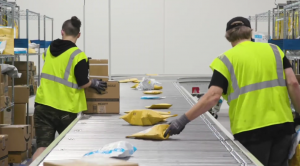E-commerce sales continue to rise, with online retail sales increasing by 2.3 percent, up to $284 billion. According to the National Retail Federation, businesses incur approximately $165 million in merchandise returns for every $1 billion in sales. As retail companies expanded their sales force to include online stores, the return and exchange policies continued to evolve.
Table of content
- What is the “Keep It” strategy for online returns?
- What are some products retailers let you keep?
- What items are online shoppers told to keep?
- How else have return policies changed?
- How are consumers reacting to the shift in return policies?
- Why have online returns become a significant problem for online retailers?
- How can consumers make the most out of their online shopping experiences?
- Responsible and ethical online shopping
According to a report by Reuters, 59% of retailers have adopted “keep it” policies for certain products this year, up from 26% last year. This is based on a survey by goTRG, a company that provides returns services, of 500 executives from 21 major retailers, including Target and Walmart.
Continue reading to discover more about the new hidden shift in online return policies and why many retailers embrace the “Keep It” strategy:
What is the “Keep It” strategy for online returns?

When returning an item you recently purchased online, you may be surprised when the retailer sends you the refund and tells you you can keep it, toss it, or give it to someone who can use it. Many online retailers now opt not to send free return labels to online buyers and instead tell them to keep the item.
Why are online retailers, such as Amazon, now allowing online shoppers to keep their returns instead of having them ship them back to the warehouse? Ultimately, it is much cheaper and more accessible for companies to let customers keep unwanted items than worry about shipping, storing, restocking, reselling, or tossing the item. Plus, they have realized it is much cheaper to let customers keep items than pay for shipping costs and employees to handle the return process. Note: If you'd like to see a full list of stores that let you keep your returns, click here.
What are some products retailers let you keep?
Reuters surveyed shoppers who claimed they were told to keep products purchased from companies including Amazon, Chewy.com, eBay, Keurig, Temu, and Wayfair. The average cost of items consumers returning to these businesses averaged between $20 and $300.
What items are online shoppers told to keep?
For fear some may abuse the policy, online retailers are not releasing what items they will tell consumers to keep instead of shipping them back. It is impossible to know if an item you purchased will qualify for the new “Keep It” policy when purchasing. Retailers only let customers know they can keep it once the return process has been completed.
How else have return policies changed?

Online returns can involve a long process and cost retailers money, which are two reasons why more businesses are switching to the “Keep It” return policy. However, to combat the many struggles online retailers face when accepting returns, the “Keep It’ policy is not the only change they are making.
Here are some of the most common changes being made to return policies for online retailers:
- Charge fees
- Have customers pay for shipping
- Encourage exchanges and returns to be made at a physical store
- Provide extensive information and photos on product pages to better educate consumers and reduce uncertainty
How are consumers reacting to the shift in return policies?

There seem to be mixed reviews on whether consumers like the new “Keep It” return policy, while others don’t mind keeping or donating unwanted items. Additionally, in exchange for paying fees or covering shipping costs, many people appreciate online retailers having physical stores where they can return or exchange items for free.
However, not everyone is happy with these changes, mainly because they feel their right to return and exchange products for free is violated. One complaint comes from Amazon charging $1 per return made through the UPS Store but still allowing for free returns made at Whole Foods (Amazon-owned), Kohl’s, or Staples.
A quick online search, especially on social media, reveals that many consumers complained and canceled their Prime subscription because of this policy. Additionally, those expressing their feelings online claim that when returns were made at the UPS Store, they could track their return. In contrast, when returning to a store, no tracking option is available.
Why have online returns become a significant problem for online retailers?

Online retailers face many challenges when dealing with returns, including losing sales, wasting resources, and lower customer satisfaction. Plus, retailers have to deal with the added costs of paying for the items to be shipped back, staff to sort and restock them, and risk items being returned in an unsellable condition.
In 2022, online retailers lost more than $816.8 billion due to returns, and the percentage of returns continues to increase. Since the pandemic, there seems to be an increase in the number of people shopping online. Plus, the ability for shoppers to “buy online and return in-store” options encourages more to shop online, increasing the number of returns.
Some retailers are doing what they can to combat the increase in online returns. Some companies boost descriptions of products and provide more images to help ensure the customer knows what they are purchasing before finalizing the order. Many retailers also encourage shoppers to read reviews and learn what they can about the product before buying it. Many online retailers add “frequently returned” labels on products with high return rates.
Below we look at the impact of returns based on global e-commerce statistics and facts over the last 3 years. To read more detailed statistics about shopping return rates, check out this other post.
| Year | Total Online Sales | Value of Returned Merchandise | Total Returns (%) | Most Common Reason for Return |
| 2022 | $5.7 trillion | $817 billion | 16.5% | Damaged or defective item |
| 2021 | $1.050 trillion | $218 billion | 20.8% | Damaged or defective item |
| 2020 | $565 billion | $102 billion | 18.1% | Damaged or defective item |


How can consumers make the most out of their online shopping experiences?
Savvy online shoppers are trying to determine how to make the most out of their online shopping experience while not being negatively impacted by the new return policies. Here are some tips to help online shoppers make the most out of their online shopping experiences;
- Read and understand the company’s return policy
- Compare product options and prices
- Be more selective and make intentional purchases
- Provide feedback and reviews to help others
- Donate or recycle unwanted items
Responsible and ethical online shopping
Online shopping makes life more convenient, plus the experience can be fun and rewarding. However, this shopping method has challenges and requires consumers to shop responsibly. Consumers influence the online retail industry based on their choices and actions, so shopping responsibly and ethically online is essential. Here are some tips to help you be a more responsible and ethical online shopper:
- Shop with local and sustainable businesses
- Select eco-friendly products and packaging
- Select a green delivery option
- Educate yourself and others
Online shopping has become a part of our lives, and there are no signs of it going away. Online retailers allow consumers to find and buy what they need and when at their convenience. However, online shopping can have some consequences, especially when making a return. Take a moment to learn more about a company’s return policy and the product you are planning to purchase, which can help reduce your need to return it, and if you must return it, you are well-informed and know what to expect.
The responses below are not provided, commissioned, reviewed, approved, or otherwise endorsed by any financial entity or advertiser. It is not the advertiser’s responsibility to ensure all posts and/or questions are answered.




